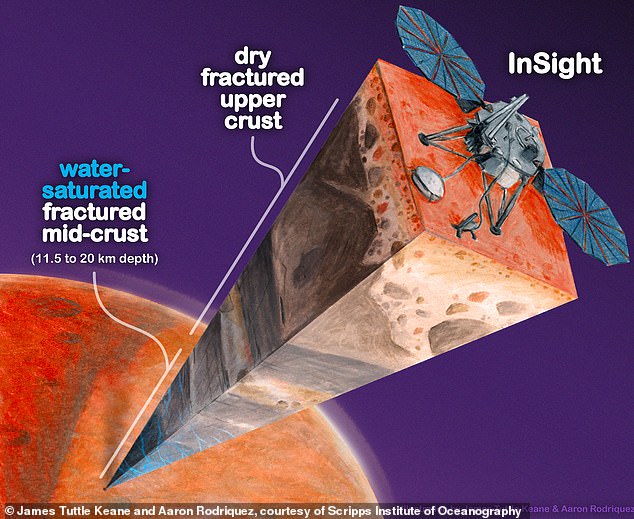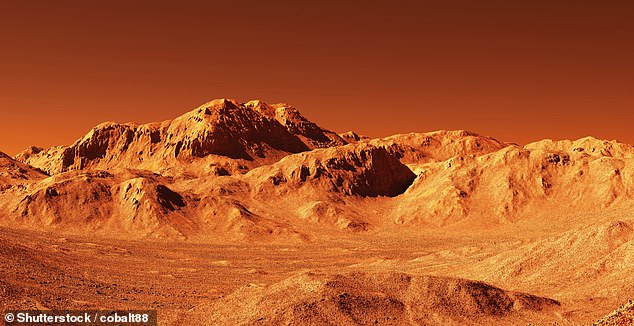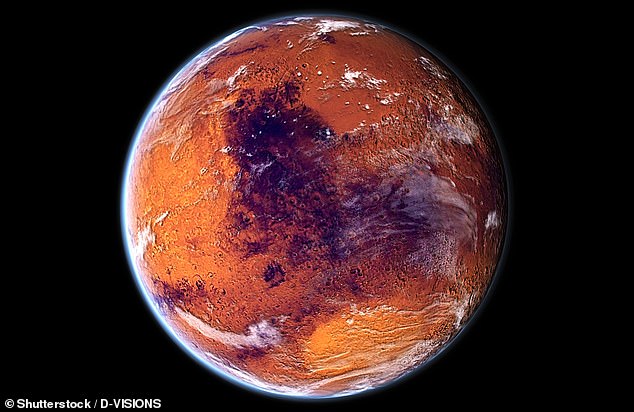- Data from NASA’s Insight lander indicate deep, porous rock filled with water
- The underground reservoir is too deep to drill with current technology.
Scientists have discovered “oceans” of water 12 miles beneath the surface of Mars that could potentially support life.
Seismic data from NASA’s Insight lander indicate deep, porous rock filled with liquid water that experts predict would cover the entire Red Planet to a depth of about a mile.
But the underground reservoir is too deep to drill with current technology, dashing any hopes that it could help support future Martian colonists.
Oceans are known to have disappeared from the surface of Mars more than three billion years ago.
The newfound water is trapped in tiny cracks and pores in the rock deep beneath Mars’ crust, between 7 and 12.5 miles below the surface.
Scientists have discovered ‘oceans’ of water 12 miles beneath the surface of Mars that could potentially support life

Seismic data from NASA’s Insight lander indicate deep, porous rock filled with liquid water that experts predict would cover the entire Red Planet to a depth of about a mile.
Drilling a hole even a mile deep is a huge challenge, even on Earth.
Geophysicists say their findings, published in the journal Proceedings of the National Academy of Sciences, point to another promising place to search for life on Mars, if it is ever accessible.
The discovery also helps answer questions about the planet’s geological history.
Dr Vashan Wright, from the University of California, San Diego, said: ‘Understanding the Martian water cycle is critical to understanding the evolution of the climate, surface and interior.
‘A useful starting point is to identify where there is water and how much there is.’
Their analysis of seismic data led to the conclusion that there is a deep layer of fractured igneous rock (cooled magma) saturated with water.

Their analysis of seismic data led to the conclusion that there is a deep layer of fractured igneous rock (cooled magma) saturated with water (artist’s impression of Mars).
Co-author Professor Michael Manga said: ‘Establishing that there is a large reservoir of liquid water provides insight into what the climate was or might be like.
“And water is necessary for life as we know it. I don’t see why (the underground reservoir) is not a habitable environment.
‘This is certainly true on Earth: very, very deep mines harbor life, the ocean floor harbors life.
“We have not found any evidence of life on Mars, but we have at least identified a place that, in principle, should be capable of supporting life.”
Professor Manga said a wealth of evidence – river channels, deltas and lake deposits, as well as water-altered rocks – supports the theory that water once flowed on the surface of Mars.
But that wet period ended more than three billion years ago, after Mars lost its atmosphere.
Planetary scientists have sent probes and landers to the Red Planet to find out what happened to that water.
They say that frozen water in the polar caps of Mars cannot explain all this, nor when it happened or whether life exists or existed on the planet.
The new findings indicate that much of the water did not escape into space, but instead seeped into the crust.
NASA sent the Insight lander to Mars in 2018 to investigate the crust, mantle, core and atmosphere. The mission ended in 2022.

